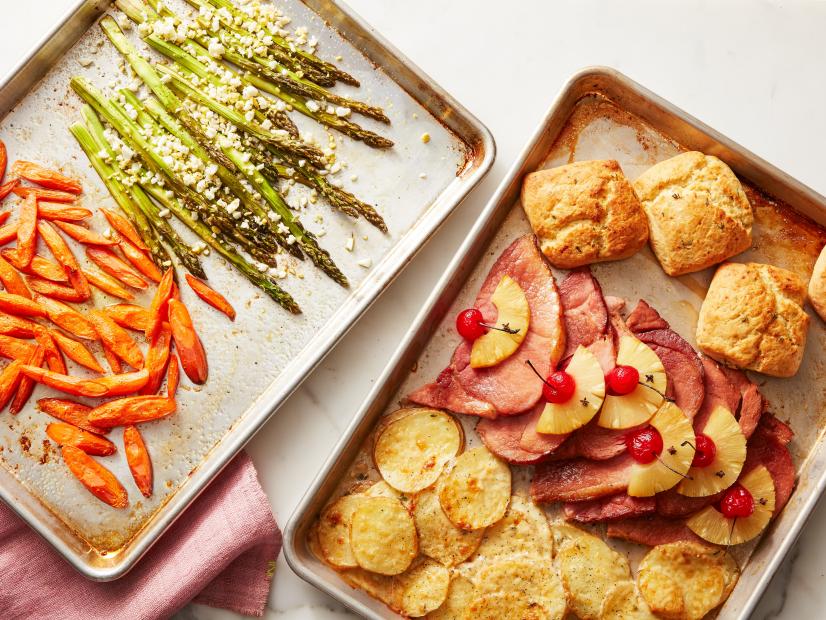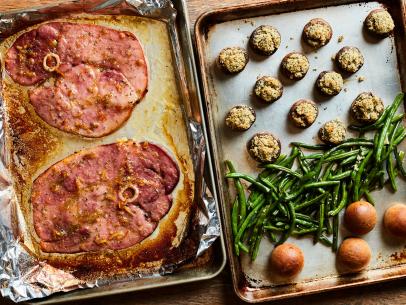
Recipe courtesy of Food Network Kitchen
Recipe courtesy of Food Network Kitchen
Watch how to make this recipe.
Easter Dinner on Two Sheet Pans
Getting reviews...
- Level: Easy
- Total: 1 hr 10 min
- Active: 40 min
- Yield: 4 servings
-
- Nutritional Analysis
- Per Serving
- Serving Size
- 1 of 4 servings
- Calories
- 1141
- Total Fat
- 65 g
- Saturated Fat
- 35 g
- Carbohydrates
- 85 g
- Dietary Fiber
- 10 g
- Sugar
- 30 g
- Protein
- 57 g
- Cholesterol
- 282 mg
- Sodium
- 4174 mg
Easter dinner for four comes together easily in a little over an hour when you cook it on a pair of sheet trays. With tender asparagus, sweet glazed carrots, a decadent potato gratin, roasted ham, and even homemade biscuits, there's plenty to eat with little fuss.
- Level: Easy
- Total: 1 hr 10 min
- Active: 40 min
- Yield: 4 servings
-
- Nutritional Analysis
- Per Serving
- Serving Size
- 1 of 4 servings
- Calories
- 1141
- Total Fat
- 65 g
- Saturated Fat
- 35 g
- Carbohydrates
- 85 g
- Dietary Fiber
- 10 g
- Sugar
- 30 g
- Protein
- 57 g
- Cholesterol
- 282 mg
- Sodium
- 4174 mg
Ingredients
Directions
Special equipment:
2 sheet pans (18 by 13 inches each) and a mandoline or vegetable slicer- Position the oven racks in the upper and lower thirds of the oven and preheat to 425 degrees F.
- Make the scones. Whisk the flour, 1 tablespoon of the parmesan, the baking powder, 1/4 teaspoon of the thyme, 1/4 teaspoon of salt and 1/4 teaspoon black pepper together in a large bowl. Add 3/4 cup of the cream and stir with a wooden spoon until the dough just comes together. Gather the dough into a ball, transfer it to a floured surface and pat into a 1-inch-thick square. Cut into 4 equal-sized square biscuits, reshaping if necessary, and transfer to a plate to chill.
- Cut the carrots into 1 1/2-inch chunks on the bias, halving any larger pieces to keep them all roughly the same size.
- Line one sheet pan with parchment paper and spread the carrots on half. Melt 2 tablespoons of butter in a small bowl in the microwave. Drizzle the carrots with the butter and 1/2 teaspoon salt and toss to coat. On the other side of the tray, toss the asparagus with 1 tablespoon olive oil, 1/4 teaspoon salt and some pepper and spread it evenly. Bake on the bottom rack until the vegetables are just beginning to become tender, 15 minutes.
- Meanwhile, slice the potatoes into 1/8-inch-thick rounds with a mandoline or a vegetable slicer and place in a medium skillet with a lid. Stir the remaining 1 cup heavy cream, the garlic, the remaining 1/4 teaspoon chopped thyme, 3/4 teaspoon salt and a pinch of pepper together in a measuring cup or bowl and pour over the potatoes. Bring to a boil over medium heat, cover the pan, and lower the heat to maintain a simmer. Cook, stirring only occasionally, until the potatoes are tender when pierced with the tip of a paring knife and the cream has thickened, 10 to 12 minutes. Remove from heat and set aside, covered.
- Remove the carrots from the oven and spoon the marmalade over them, stirring until completely coated. Turn the asparagus spears and return the baking sheet to the oven.
- Butter 1/3 of the clean sheet pan. Spoon half the potato slices into an even, overlapping layer on the buttered area and sprinkle evenly with 1 tablespoon of the Parmesan. Top with the remaining potato slices, spoon any remaining cream over, and sprinkle with the Gruyere and remaining tablespoon of Parmesan.
- Arrange the ham slices in a single overlapping layer down the center of the sheet pan, leaving an empty space for the biscuits. Mix the brown sugar and pineapple syrup together in a small bowl and heat in the microwave for 30 second increments, stirring in between until the sugar has melted. Spoon the glaze onto the ham slices and spread it with the back of a spoon to cover. Cut the pineapple rings in half and lay a piece on top of each ham slice. If using, place a maraschino cherry half in the center of each pineapple slice and pin it down with a clove. If not, pin the pineapple to the ham with the clove.
- Evenly space the chilled biscuits on the tray and brush the tops with cream. Place the tray on the higher rack of the oven. Cook both trays until the potatoes are brown and crusty on top, the carrots are glazed and fully cooked, the asparagus is tender and lightly browned, the scones are golden, and the ham and pineapple are warmed through, about 20 minutes.
- To serve: Stir the carrots and grate the hard-boiled egg over the asparagus. Divide evenly among 4 plates. Serve with lemon wedges and mustard on the side.
Cook’s Note
When measuring flour, we spoon it into a dry measuring cup and level off the excess. (Scooping directly from the bag compacts the flour, resulting in dry baked goods.)

































